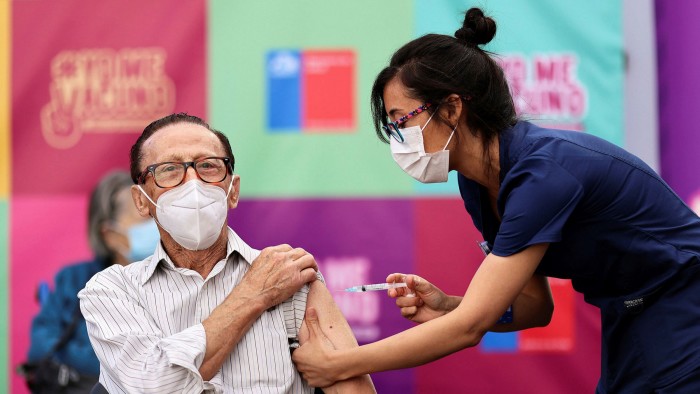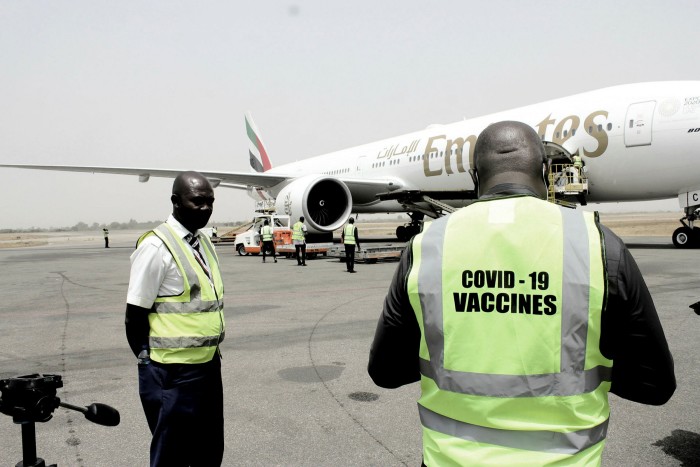How sustainability bonds bridged the vaccine funding gap for poorer nations

Roula Khalaf, Editor of the FT, selects her favourite stories in this weekly newsletter.
When it became clear early last year that the Covid-19 outbreak in China would become a pandemic, few organisations were better positioned than Gavi. The UN-backed vaccine alliance, founded in 2000, had experience with children’s inoculation programmes and had helped develop and secure the Ebola vaccine.
“We came quickly to the conclusion that having a mechanism that would allow us to front-load donor funding would be very important,” says Marie-Ange Saraka-Yao, a Gavi managing director responsible for, among other areas, innovative finance.
Even without knowing how soon a vaccine could be developed, she was clear it was important to secure doses for lower-income countries as soon as possible.
Early on in the pandemic, many wealthier countries and large philanthropic organisations wanted to pledge money towards vaccination efforts in lower-income countries.
But, considering the constraints of annual budgets and the urgency of managing the pandemic at home, few would be able to provide all the funding immediately. Vaccinations, however, needed to start urgently.
The International Finance Facility for Immunisation (IFFIm) saw “vaccine bonds” — sustainability bonds that go towards vaccination efforts — as a solution. Donor countries and organisations make pledges to IFFIm to be used for vaccinations. Then, based on the strength of those promises, IFFIm sells these bonds.
The sole purpose of IFFIm is to fund Gavi, which can then go ahead and act quickly to secure vaccine doses. After five years, as donor countries make good on their promises, investors in the vaccine bonds receive a return on their investment. The credit rating is based on the credit rating of the donor countries.
Vaccine bonds have their origins in green bonds. Development banks, for example, issue green bonds, earmarked to fund green projects such as those combating climate change. While they were slow to take off, green bonds are now a trillion-dollar industry.
Gradually, sustainability bonds, which can cover a broad spectrum of projects, including green projects, became more popular. In 2020, the sustainability bond market increased eightfold, according to data provider Refinitiv.
The pandemic brought a sense of urgency to this growing market, changing the focus and scale of sustainability projects. The IFFIm bonds, unlike typical sustainability bonds, have a direct link to the vaccine: funds go straight from one to the other, via Gavi and Covax (Covid-19 Vaccines Global Access, a worldwide initiative — co-directed by Gavi — aimed at equitable access to Covid vaccines). IFFIm issued a $500m vaccine bond last October and a $750m one this April.
With IFFIm, “the due diligence is very simple — there’s no additional confirmation or opinion needed”, says Carol Piot, special adviser to IFFIm’s board of directors.
Covax’s Advance Market Commitment mechanism is providing free vaccinations to 92 lower-income countries and has so far raised $6.7bn. Covax has struggled to compete with bilateral deals made between vaccine manufacturers and rich countries, but Gavi has helped it secure 2.1bn doses up to the end of this year, according to Covax’s supply forecast, exceeding its target.
“We’re at a bit of a tipping point,” says Kenneth Lay, chair of IFFIm’s board of directors. “The momentum for this is huge.”

While the IFFIm vaccine bond model can provide funding quickly, conventional bonds from development banks earmarked for broader Covid-related projects can deliver on a huge scale. The World Bank made the largest ever US dollar-denominated bond issue by a supranational last year. It was an $8bn, five-year sustainable development bond which was followed by similar bonds of $6bn and $3.5bn, among others.
These go towards financing the World Bank’s pledge of $160bn aimed at helping countries with their pandemic recovery, $12bn of which will be used specifically for vaccination efforts in developing countries. The aim is to reach 50 countries with these vaccination projects by the middle of this year.
“Accelerated vaccine availability to developing countries is not only good for developing countries, it’s good for humanity,” says Jingdong Hua, World Bank vice-president and treasurer. “If the vaccine can be available in an accelerated fashion, we can see global [gross domestic product] go up by a whole percentage point. We need global immunity to make good things happen.”
Now, investors better understand the financial implications of not being prepared for pandemics and climate change. Their sense of social responsibility too has taken a central role in investing decisions.
“We see a transformation of the objectives of investors, particularly the younger generation who want to know that the destination of their investments have a green or social impact and this is not going to change,” says René Karsenti, senior adviser and former president of the International Capital Market Association. “I believe this is one of the most important trends taking place in finance.”
In the first quarter of 2021, sustainability bonds reached a new high of $287bn, according to data from Refinitiv, more than doubling the previous year’s record-breaking figures.
“The purpose of finance is to connect those that have to those that need,” said Hua. “The pandemic and climate change humbled us to say, it doesn’t stop at national borders. We really need a global solution, a multilateral solution.”
The pandemic has accelerated the trend towards sustainability bonds and responsible investing. Increasingly, investors want to know where their money is going and ensure it is being used for responsible projects.
“In the future,” says Heike Reichelt, World Bank head of investor relations and sustainable finance, “my hope would be that investors will choose to only be financing sustainable investments and everything will be considered ESG [environmental, social and governance] investing.”
Comments